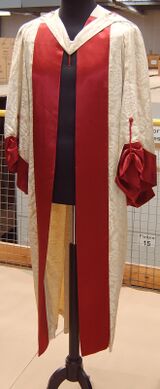Academic Dress in the United Kingdom
The United Kingdom has a rich tradition of academic dress, going back to mediaeval times and the foundation of England’s ancient universities. Initially, the wearing of gowns, hoods, capes and funny hats was normal behaviour, and scholars were indistinguishable from the average civilian, but, due to academics’ fondness for tradition, fear of catching a cold, and secret enjoyment of wearing women’s clothes, these practices continued virtually unaltered. Today, almost every university in Britain has a unique style of dress, used mostly at graduation ceremonies. The style of hood often allows the observer to tell what degree the wearer is being awarded, thus allowing them to respond with the appropriate amount of snobbery/flattery. In some universities, however, such dress is used frequently, usually to bait tourists and/or intimidate university servants. Some would consider such practice an anachronism, but they would, of course, be forgetting that England's entire system of education is an anachronism, and that comparatively, wearing a cape is positively modern.
Composition
The basis of most academic dress is the gown. This simple piece of cloth developed from the dressing gown, which, due to their incurable laziness, was commonly worn by most humanities students until at least 3PM. The Senate of Oxford, wishing to present a smarter image to the hordes of Japanese tourists already thronging the streets, decided in 1364 to formalise the gown as official uniform. This was seen as a good idea, and quickly adopted by the University of Cambridge too. It is also recorded as the last good idea to have come out of Oxford, and as such was an important event in the history of education in Britain. The new formal gown was plain black for undergraduates in an effort to hide beer/port/vomit/blood stains, but recipients of higher degrees were deemed responsible enough to get colourful gowns. How wrong they were.[2][3]
The shape of the gown differs according to institution, degree, and, until recently, social class. Traditionally, this would have been for ease of persecution, but this is largely redundant now. Most of the time, candidates for the post of persecutee are now spotted by more subtle social signs, as opposed to a band of velvet on their clothes being 1.75 in. wide instead of 1.5 in.[4] This is not the case universally, however. Students of the Open University still have distinctive gowns for this very purpose, as do Scottish students (see below).
Graduates of a degree are entitled to a hood corresponding to their highest degree. Under no circumstances, however, must they put the hood over their head. This is widely regarded as unacceptably chavvy, and in many universities merits expulsion. Instead the hood hangs at the back, a three foot long tangle of coloured silk, fur and tassels. This, of course, demonstrates the class and impeccable dress sense of students, worn with pride and the odd stain. Each subject has a differently coloured silk lining, again providing opportunity for snobbery and derision. Critics have, unsurprisingly, criticised these distinctions, pointing out that such a system is unfair to graduates of psychology or theology. The general consensus, however, is that said graduates ought to have thought harder about their degree choice if they wanted to avoid embarrassment.
Graduates are also entitled to the wearing of a hat, often a mortarboard. In an odious and vulgar act of waste, however, most graduates chose to throw their hat away within minutes of receiving it. The origins of this tradition are not known for certain, although one theory suggests it may have origins in “the enjoyment of watching servants sweeping a street full of hats”.[5] Other types of hat are sometimes awarded, especially for doctors. These include the Tudor Bonnet, Pileus, Bishop Andrewes Cap and, in many ex-polytechnics, the Baseball Cap (usually emblazoned with sponsor’s logo).
Scotland
In Scotland, academic gowns are traditionally red. This is most likely due to the demands of Scottish citizens themselves; in Scotland, especially Glasgow, education is seen as a dangerous thing, and people possessing it are feared intensely. Forcing students to wear highly visible clothing allows locals to stay away from such dangerous individuals, and thus not become contaminated with thoughts of "philosophy" or "science". Another interesting theory suggests differently, however. Recently unearthed evidence shows that back in England's ancient universities, red gowns were commonly issued to dunces to shame them. It is possible, and even quite likely, that the first lecturers, on arriving at the newly-established St Andrews University found the need to issue these gowns to everyone, and the tradition has been retained.[6]
Usage
In most universities, academic dress is only worn on occasions of great ceremony, such as graduation, the installation of a new chancellor, or pub crawls. As a consequence, most students don’t own a set, but rent one as required. Most universities agree that wearing of such clothing dramatically increases students' pride in their institution, and also their academic performance. For this reason, they are only worn on completion of degrees, the rationale being that pride and academic performance are dangerous things, liable to bring students out of a state of stupor. This could even lead to them realising that they're paying £9,000 a year for half-pissed lecturers who can't even tie their own shoelaces, clearly a revelation to be avoided.
A few universities (Oxford, Cambridge, some Durham colleges) insist on the wearing of gowns by undergraduates in daily life. It is rumoured that some Oxford colleges (especially the remaining all-male ones, for some reason) insist on students wearing a gown only.[7]
Traditionally, students at Oxford would kneel in front of the Chancellor and be tapped on the head with a bible at their graduation, purportedly to "get something into those thick skulls of theirs", according to its first Chancellor. A gentle tap, however, soon developed into one last opportunity to punish unruly students, and by the mid-sixteenth century sharpened metal "bibles" were routinely being used, with fatal results. It is believed this is why mortarboards today have a hard top, the result of an "arms-race" between students and masters. The public outcry over Plutonium-enriched bibles used in the late 1950s, and the consequent lead-lined mortarboards, eventually resulted in the discontinuation of the tradition, but mortarboards retained their hardened covering, coincidentally allowing the balancing of drinks on the head, giving students of philosophy a sense of purpose.
Controversy
Historically, a major component of the gown and hood was a fur trim. This has now largely been dropped after conflict with animal rights activists. The RSPCA first complained in 1973, when the University of Life (Oxford Campus) chose to switch to artificial fur for reasons of cost. They pointed out that, for reasons unknown, baby seals often wore fur in "coats" rather than gowns. These "coats" are very uncomfortable, and people should make an effort to remove them. However, just to spite the lefty, Guardian-reading spoilsports that are animal rights activists, every university in the country pledged to drop fur from their gowns. Such a move was deeply unpopular, but was generally accepted as necessary to teach the RSPCA a lesson.[8] Fur is now only used by a handful of students, usually the socially-conscious, vegetarian activists, and usually only to make a point.
The Burgon Society

The Burgon Society, founded in 2000, is a learned society dedicated to the study of academic dress. Membership is restricted to those who have published a significant amount of high-quality research on the subject, and, if chosen, fellows have the right to use the post-nomial FBS. Perhaps realising that the amount of material to study doesn't really warrant an entire learned society solely dedicated to it, the fellows have so far spent most of their time designing the Society's own dress. As may be expected, the full dress is exceptionally complicated, and when worn properly weighs well over 10 stone. Because the fellows are largely academics over the age of fifty, and thus unable to support such a heavy load, it is the only known set of robes to incorporate steel scaffolding and wheels. This had led to the annual meeting of the Society becoming a bit of a tourist attraction, especially watching the fellows climb two flights of stairs.
Since the design was completed in 2011, after many years of hard work, the Society has been somewhat at a loose end. Work has now started on finding a Latin name for their discipline, which is expected to take at least five years.
The Society publishes a peer-reviewed journal, The BS Transactions, widely regarded as foremost amongst publications dealing with the shape, colour and pattern of cloth in clothes worn by a fraction of the population once in their life and then discarded. As a result of the urgent nature of their research, the Charity Commission has accorded them the status of a charity, and the UK Research Council has allocated almost a quarter of its budget, as "Cancer Research is somewhat over-rated".
References
- ↑ Taken from Wikipedia: "Academic dress of the University of Cambridge" (June 2013). See table describing gowns.
- ↑ The Orange Gown Riots Of 1874: A Concise Analysis (OUP, 1989). Pages 3 - 1476.
- ↑ The Great Bristol Famine Of 1967 (Ladybird Picture Books, 2001). Chapter 12 (Academic Dress As A Causal Factor).
- ↑ Commoners, Plebs And Oiks: How To Identify And Destroy Them (Reader's Digest Survival Guides, 2011). Read the entire book, if you can.
- ↑ Cambridge In My Time (Stodder & Houghton, 1894). Page 57.
- ↑ To What Extent Are Scottish People All Thick? (TLS, Issue 352, 1995). Page 17.
- ↑ The Orgies Of Oxford: A Pocket Guide (Puffin Classics, 1978). Pages 46 - 63.
- ↑ A Brief History Of Baiting Lefties (OUP, 2006). Chapter 8 (Dealing With Tree-Huggers, Or Badger Culling For Dummies).
| Poo Lit Surprise-Winning Article | |
This article was chosen as the Best Article in the Summer 2013 Poo Lit Surprise writing competition.
| |
| Featured version: 25 July 2013 | |
| This article has been featured on the main page. — You can vote for or nominate your favourite articles at Uncyclopedia:VFH. | |




